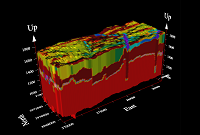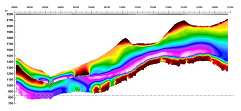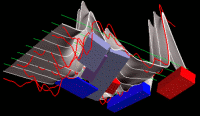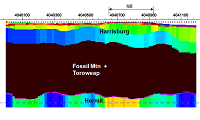Download Airborne FEM demo database
Download Airborne TEM demo database
(works with our EMIGMA Demo)
Airborne TEM software package is available as an add-on to other EMIGMA Premium packages or as a standalone product. The package includes the tools for airborne FEM, ground FEM or ground TEM data.
In the airborne FEM method, the transmitter and receiver coils are generally housed in a single case and are towed by a helicopter, whereas airborne TEM transmitters are either attached to the fixed wings, nose and tail of an aircraft and a 3-component receiver is housed in a towed bird or the system has a towed transmitter with one or more receivers. EMIGMA provides configurations of helicopter TEM systems for both central loop and Slingram styles.
Airborne FEM and TEM offer the advantage of collecting large amounts of data over a relatively short period of time. Being not limited by the geophysical survey size, EMIGMA allows for rapid airborne FEM and TEM modeling and inversion within a full contrast range from massively conducting targets in a resistive environment to resistive targets inside a conducting earth, for any number of plate, prism and polyhedra anomalies. EMIGMA is an excellent tool for survey design as well as for interpreting your data.
Unlimited Survey Size!
Data Import
- FEM data imports from either ASCII or .qct files and some manufacturer's formats. As data is often delivered in a .gdb format, it can be imported to QCTool, manipulated and then the resulting .qct file may be imported very simply to EMIGMA.
- Airborne TEM (Fugro GeoTEM/MegaTEM/HeliGeoTEM/TEMPEST, VTEM, AeroTEM, SKYTEM) as ASCII or by .gdb through QCTool. QCTool is provided with the license. QCTool has the advantage of allowing easy QC/QA and data merging and cleaning of your survey prior to import to EMIGMA for interpretation
Data Processing and Correction
- 1D digital and spatial filters , 2D spatial filters
- Simple and weighted averaging decimation. As airborne data is often oversampled when compared to the height and size of Tx, it is best to decimate the data. Using a weighted average decimation reduces noise levels as it is decimating.
- Average duplicates, remove outliers, merge lines or surveys
- Data Spreadsheet tool combining dynamic spreadsheets and line plotter for data cleaning, missing data interpolation and simultaneous plotting of different data channels for fast cross-analysis
Data Display and Analyses
- Display of data over flight altitude variations, GPS positions
- Display of Apparent Resistivity as a surface or spatial contour
- PEXShow tool - 2D representation of geoelectric sections
- Display of section cutting of 3D models in the 3D Visualizer
- Grids: Natural Neighbor, Delauney Triangulation, Shepard, Minimum Curvature and Thin-Plate-Splines
- Contours: 2D and 3D surfaces
- Time decay rate and amplitude contours (TEM)
- Line plots
- Residual plots
- Overburden model removal processing
- For more detailed data display capabilities, see EMIGMA Complete
3D Modeling
- Fast and accurate 3D simulations: model suite generation and batch mode
- Prisms, thin-sheet plates, polyhedra and sphere targets
- Multiple body interactions
- Modeling of topography effects
- Modeling of magnetic effects in EM data
- Accounting for variations in resistivity, susceptibility and Cole-Cole parameters
- Ability to handle full contrast between host and bodies
- Incorporation of altitude information
- Interactive 3D model building tool
1D FEM Inversion
- Multi-Component and/or Multi-Frequency inversions, Inphase/Quadrature or Quadrature only
- Three algorithms to choose from
- Smooth Occam resistivity inversion with fixed layer thickness
- Smooth Occam joint susceptibility/resistivity inversion with fixed layer thickness with user defined starting models
- Underparametrized Marquardt Inversions - invert for thickness and/or resistivity
- User defined starting models
- User defined parameters for inversion
- Full resistivity and thickness constraints
- Spatial smoothing capabilities
- Suite of minimization techniques
- Incorporation of GPS_Z information
1D TEM Inversion
- 2 inversion techniques - Smooth Occam and an underparametrized Marquardt style
- 2 Forward techniques - one is approximate utilizing a causal transform and the other is accurate using accurate system response
- User defined starting model - multiple starting models allowed
- User defined inversion parameter and constraint definitions
- Multi-station, Multi-parameter inversions allowed
- Spatial inversion weighting
- Production orientated - inversions saved at regular intervals, inversion parameters saved to recoverable log files, inversion progress outputs, intermediate stops and restarts allowed
TEM Pseudo Inversion
- Display of time decays (layered or 3D) for user selected time windows
CDIMAP
- Apparent Resistivity Tool - a half-space mapping technique for generating apparent resistivities as a function of frequency
- Sengpiel Depth-Sections - a resistivity pseudosection technique for generating resistivities as a function of pseudo-depths
Export
- Images exported to postscript files, raster or GeoTIFF formats
- Data export to XYZ ASCII, .GBN, .QCT, other EMIGMA databases (measured, modeled, inverted)
- Inversions exportable as volumes or depth slices to ASCII or QCTool file
- Grids to XYZ ASCII or Geosoft/Surfer formats
- Models exported to EMIGMA or GeoTutor formats
- 3D models may be exported to CAD formats







